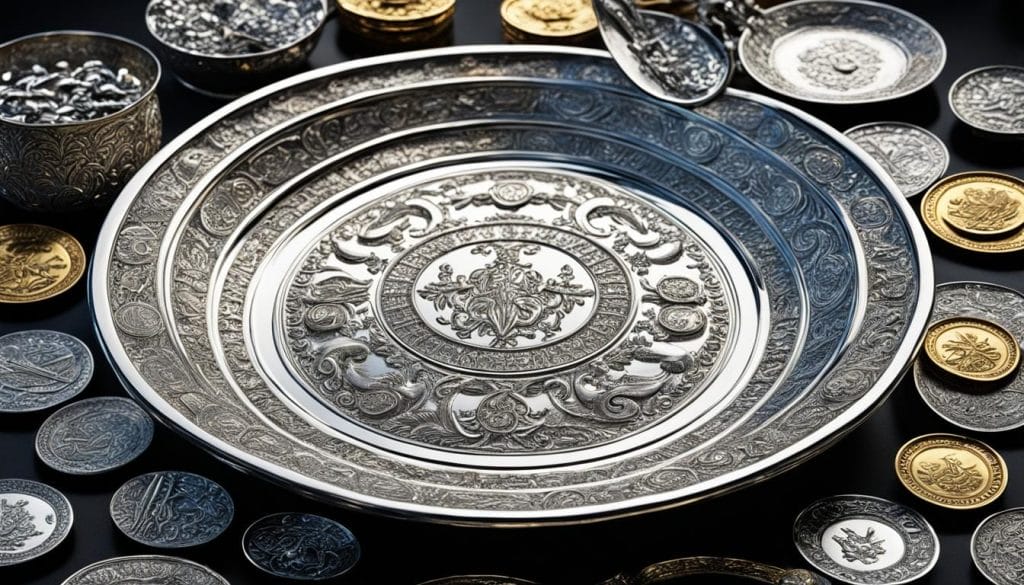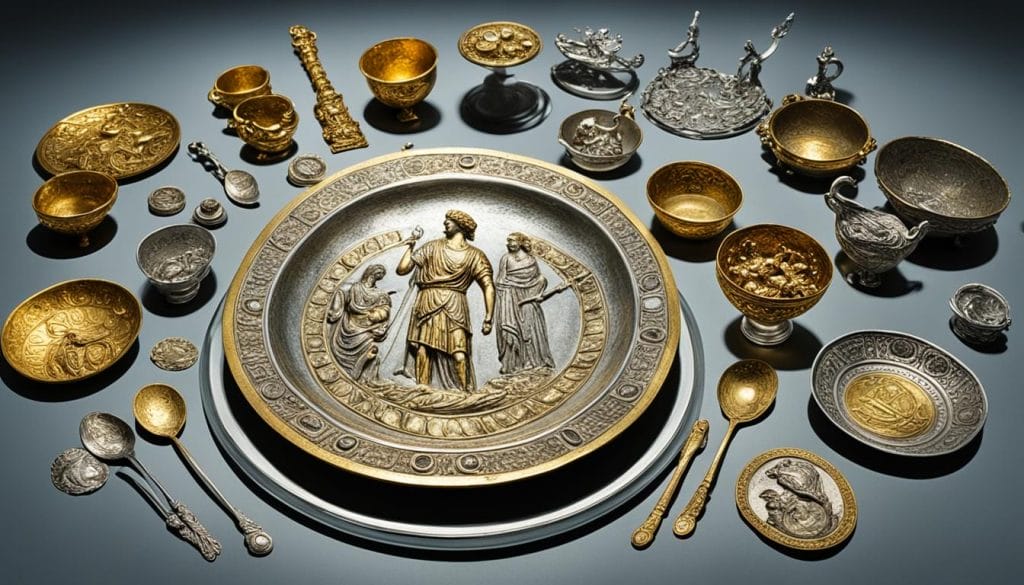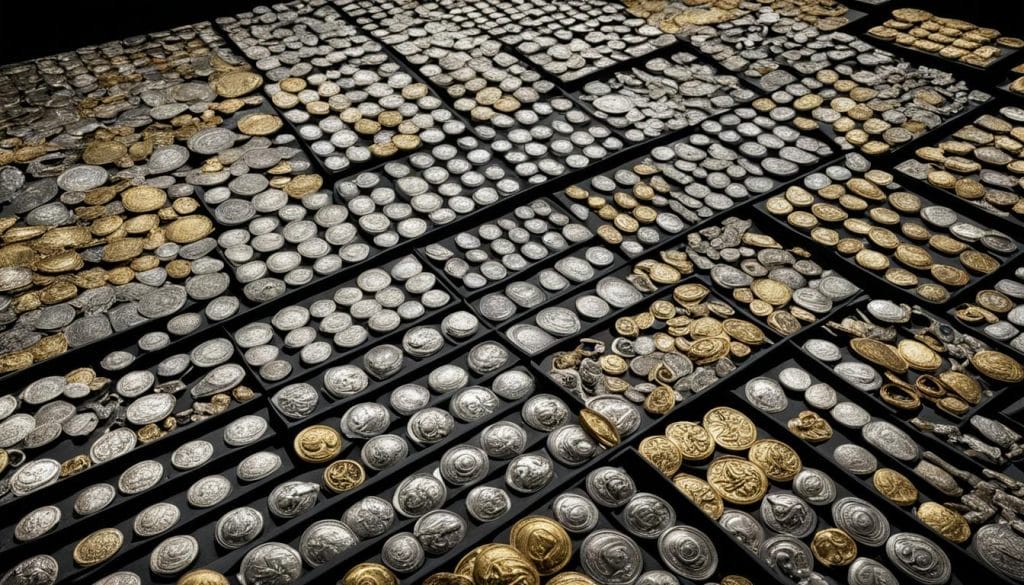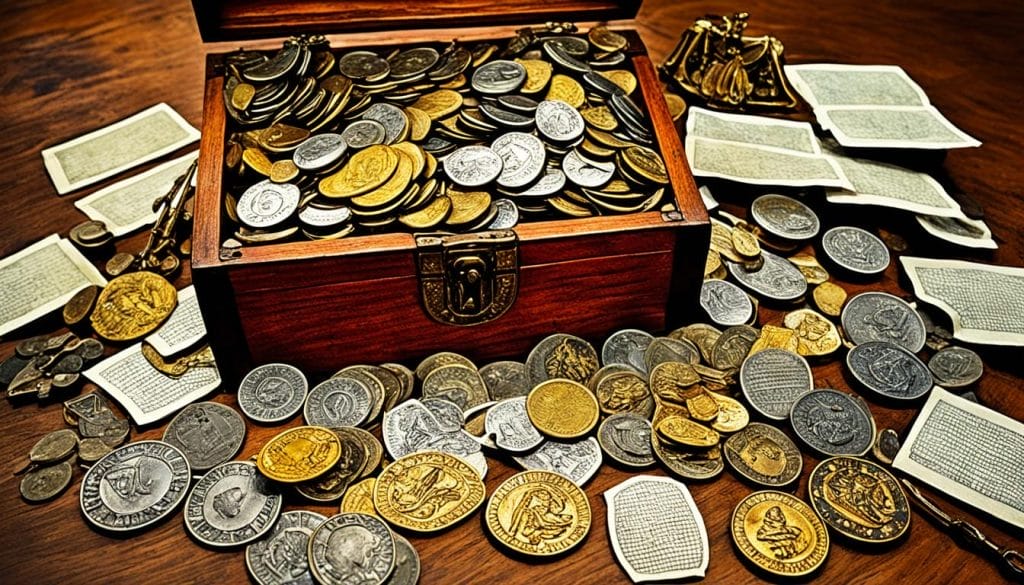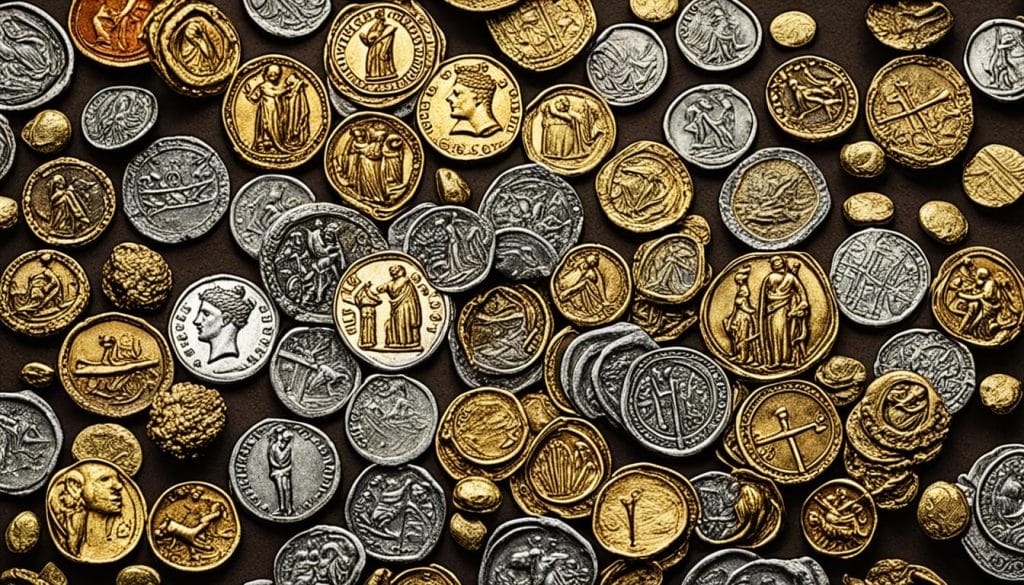The quiet Suffolk countryside in England was once center stage for one of the most remarkable finds in archaeological history. Dubbed the Hoxne Hoard, this incredible Roman treasure, uncovered by the looping swing of a metal detector, rewrote the chapters on Roman Britain and bedazzled the halls of the British Museum with its magnificence. Buried for centuries, the largest hoard of Roman gold and silver was resurrected from the earth by chance and quiet perseverance, merging the past with the present in an extraordinary tale of discovery.
It’s a testament to the serendipity of history that a metal detector discovery could lead to the unearthing of one of the Great Britain’s most precious legacies from its ancient past. The Hoxne Hoard is not only a collection; it’s a narrative woven in precious metals, telling stories of wealth, artistry, and the enigmatic lives of those who roamed Britain during her Roman tenure.
Key Takeaways
- The Hoxne Hoard, discovered in 1992, is a time capsule from Roman Britain.
- Unearthed by metal detectorist Eric Lawes, this find is the largest hoard of Roman gold and silver in Britain.
- Housing 14,865 Roman coins and numerous precious artifacts, the hoard offers a glimpse into the wealth of Roman-era Britain.
- Displayed in the British Museum, the treasure allows the public to witness the grandeur of historical craftsmanship.
- The discovery exemplifies the potential for metal detectorists to contribute significantly to historical knowledge.
- The Hoard continues to generate intrigue and insight into the lives of Britain’s former Roman residents.
- The treasure’s concealment remains one of history’s enduring enigmas, tempting the curiosity of both scholars and enthusiasts.
Unearthing the Hoard: A Serendipitous Discovery
In the quaint setting of Hoxne village, an unassuming event unfolded into a historical spectacle. The small town in Suffolk became the epicenter of a serendipitous find, forever changing how we appreciate the past. One of the most significant moments in metal detecting history was written not by chance, but through an act of keen observation and civic duty by an individual named Eric Lawes.
The Tale of a Lost Hammer and a Found Treasure
It began with the simple misplacement of a hammer on a farm field. In trying to locate it with his metal detector, Lawes unearthed something far more precious than the missing tool: a Suffolk treasure that had been awaiting discovery for centuries.
What lay beneath the rich soil was not what he had expected. Instead of cold steel, he found silver spoons, gold jewelry, and coins—a veritable trove thought to be lost to time. Recognizing the importance of his find, Lawes spared no time in contacting the proper authorities, catalyzing what would become a meticulous archaeological excavation. This action safeguarded the historical integrity of what is now known as the Hoxne Hoard.
The Role of Eric Lawes in Recovering History
Eric Lawes is often hailed as the responsible custodian of history, finds himself a key figure in this narrative. His decision to seek out archeological experts instead of pursuing further discovery on his own marked a turning point. This prudence and respect for historical preservation underlie the true spirit of metal detecting as a pursuit that can yield discoveries of immense importance.
Collaboration Between Metal Detectorists and Archaeologists
The subsequent excavation, led by the adept hands of the Suffolk Archaeological Unit, underscored the potential for harmonious collaborations between metal detectorists and archaeologists. Together, they successfully recovered the hoard, mainly undisturbed and neatly compartmentalized within its wooden chest. Due to this partnership, the treasure was transferred securely and swiftly to the guardianship of the British Museum, where it underwent conservation efforts undisturbed by media frenzy.
This foundational event created ripples that improved relationships between treasure hunters and academic preservers, and ultimately contributed to a landmark change in legislation surrounding found treasures. It highlights how a single serendipitous discovery can intertwine the lives of individuals with the annals of history, reinforcing the bond between past and present.
The Historical Significance of The Treasure of Hoxne
Unveiling a treasure such as the Hoxne Hoard opens a window to the opulent life once led by the upper echelons of late Roman British society. This vast collection of late Roman silver and other precious metals is more than just a cultural heritage landmark; it’s an illuminating beacon of archaeological significance. The hoard, as an unparalleled historical treasure, sheds light on the monetary systems and domestic practices characterizing the dawn of the fifth century.
The systematic arrangement of the Hoxne treasures suggests careful preparation and preservation, hinting at the economic upheaval prevalent during the cessation of Roman rule in Britain. Each artifact, snugly packed within its own space, stands as testament to a period riddled with societal flux and existential dread.
The careful concealment of such wealth signals the dramatic shift from Roman order to the unknown, casting a spotlight on the deep roots of cultural significance the hoard has planted within historical narratives.
It is through the intricate silverware, delicately crafted jewelry, and assorted coinage that we begin to reconstruct the lifestyle patterns and economic networks that wove through late Roman Britain. To understand the full gravity of the Hoxne Hoard’s enchanting story is to acknowledge the silent yet powerful statements laden within its context.
| Artifact Type | Description | Significance |
|---|---|---|
| Gold Coins | Issued by emperors from various periods, high in purity. | Mirrors the economic stature and stability prior to societal shift. |
| Silver Tableware | Includes spoons and ornate serving dishes. | Reflects the domestic affluence and banquet culture. |
| Jewelry | Intricate necklaces and body chains in gold. | Indicative of high fashion and personal adornment practices. |
In essence, each piece of the Hoxne Hoard articulates a chapter of a story that has captivated historians and enthusiasts alike. Not only do these ancient relics enable us to glimpse the prestigious backdrop against which they were fashioned and enjoyed, but they also allow us to appreciate the sheer breadth of historical knowledge they embody.
From the relics of cultural heritage carved in late Roman silver to the layers of soil that encapsulated them, the Hoxne Hoard remains a defining historical treasure with resounding archaeological significance.
The Roman Empire’s Wealth in Britain
The discovery of the Hoxne hoard illuminates the exceptional Roman Empire wealth that permeated Britain during the late Roman period. Reflecting more than mere affluence, the hoard’s composition of silver treasure, gold artifacts, and numerous Roman coins tells a wider story of the economic prowess that once thrived in this province of the expansive Roman world.
Largest Hoard of Late Roman Treasure Uncovered
The Hoxne hoard, a remarkable repository of wealth, stands as a testament to the storied past of the Roman Empire’s presence in Britain. With an array of highly valued gold solidi coins found within, this once-hidden treasury is a key to understanding the economic foundations and sophisticated transactions that were commonplace in late Roman society.
A Diverse Collection: The Mix of Precious Metals and Objects
As part of this diverse collection, the exquisite craftsmanship of silver spoons, a silver tigress handle, and a variety of lavish silver vessels, alongside the famed silver-gilt pepper pots, is not only indicative of material wealth but also of cultural prosperity. These finely wrought gold artifacts and Hoxne artifacts allow us to glimpse into the everyday life and opulent tastes of those who dwelled in late Roman Britain.
- Gold Solidi Coins: Reflecting the highest denomination of currency in the Roman economy
- Silver Miliaresnses and Siliquae Coins: Testifying to the complex monetary system
- Silver Tableware: Indicative of the domestic elegance in Roman Britain
- Gold Artifacts: Exhibiting luxury and high societal status
- Silver-Gilt Pepper Pots: Demonstrating the Roman penchant for exquisite table accessories
Each item within the hoard contributes to a richer understanding of the Roman Empire’s wealth in Britain, evoking the grandeur of an empire that, even in distant provinces, displayed a remarkable command of resources and artisanal expertise.
Deciphering the Past: The Contents of the Hoard
Through meticulous Roman artifact analysis, the Hoxne Hoard offers a rare glimpse into the affluence and cultural dynamics of later Roman Britain. The careful examination of the Hoxne Hoard contents reveals a staggering collection of gold coins, sophisticated silver tableware, and modest bronze coins, each telling a story of wealth, artisanship, and daily life.
The hoard’s numismatic components—precious coins in remarkable quantities—underscores the economic stature of its owner. The hoard included 569 gold solidi, primarily used in high-value transactions and as savings, representing the pinnacle of late Roman currency systems.
In addition to currency, personal adornments and household items speak volumes about their owner’s lifestyle. Among the hoard was a collection of 29 pieces of gold jewelry and over 98 pieces of silver spoons and ladles, some intricately designed, reflecting a luxurious domestic setting.
- Gold jewelry and coins uncover aspects of wealth and status.
- Silver tableware and utensils disclose refined tastes and dining customs.
- Bronze coins exhibit broader economic transactions and circulation.
The following table illustrates a comparative inventory of the Hoxne Hoard, categorized by material and type, offering a structured overview to appreciate the diversity and quantity of the items discovered.
| Material | Type of Items | Quantity |
|---|---|---|
| Gold | Coins (solidi) | 569 |
| Silver | Coins (miliarenses and siliquae) | 14,272 |
| Bronze | Coins (nummi) | 24 |
| Gold | Jewelry | 29 |
| Silver | Spoons and ladles | 98 |
The way these treasures were buried, in an oak chest with smaller compartments made from yew and cherry wood, sheds light on the care taken in their storage and the anxiety of uncertain times. Whether for preservation or in preparation for a hasty departure, these pieces—artifacts of life and luxury—were tucked away, thereby freezing a moment in time.
Ultimately, engaging in the detailed Roman artifact analysis of the Hoxne Hoard contents does not just enumerate items of wealth; it reconnects us with the narratives of ancient human experiences through the tangible remnants they left behind.
Exploring Intricate Artifacts: Gold Chains and Empress Pepper Pot
The storied Treasure of Hoxne is not only a valuable cache of Roman coins but also a repository of some of the most exquisite artifacts from ancient Rome. Among these are the intricate Roman artifacts like the ornate gold body chain and the ornamental tableware that includes the lavish silver-gilt pepper-pots. These items not only reflect the wealth of their owners but also offer a glimpse into the remarkable craftsmanship of the Roman era.
The gold body chain, designed as a statement of luxury and status, reflects the fashion and social strata of Roman society. The craft required to create such Roman jewelry suggests a society of affluence and sophistication. Similarly, the silver-gilt pepper pots that adorned the tables of the Roman elite are not merely functional items but are imbued with cultural significance.
Rare Objects: From Jewelry to Silver Tableware
As we delve deeper into the collection, we discover that each piece of the Hoxne Hoard was carefully manufactured to serve as both utilitarian and symbolic. The opulence of Roman jewelry, represented by the shimmering gold body chain, reveals the individual tastes of the era while also signaling their social standing. The ornamental tableware is equally captivating, with silver-gilt pepper-pots elegantly crafted to please the eye and serve as testament to their owner’s rank.
These artifacts, painstakenly recovered and preserved, continue to enchant with their beauty and the tales they tell of the past.
Examining the “Empress” Pepper Pot
The “Empress” Pepper Pot is a resplendent example of Roman craftsmanship and cultural interchanges. Created from fine silver and gilded with gold, this pepper pot is not just a condiment container but a piece of art. The intricate design is highlighted by the depiction of a high-status woman, a motif that speaks volumes about the social order and global commerce of the period, notably the trade of exotic spices like pepper from India.
This sophisticated artifact, along with the other entrancing pieces from the Hoxne Hoard, serves as a time capsule that transports us back to the grandeur of the Roman Empire. Its meticulous artistry and form function both as a utilitarian object and as a symbol, immortalizing the opulence and far-reaching connections of its era.
Fate of the Hoard: Acquisition by the British Museum
Emerging from the hidden depths of Suffolk, the acclaimed Hoxne Hoard’s journey to state recognition and educational prominence sets a benchmark for artifact valuation and cultural heritage preservation. Upon its valuation, the British Museum rightfully included this treasure in its historical exhibition, celebrating the intricacy and richness of Roman Britain. The transition from buried treasure to an invaluable educational display reflects not just a monetary transaction but a deeper commitment to unearthing the past for future generations.
Valuation and Display of the Hoxne Artifacts
The meticulous appraisal of the Treasure of Hoxne, leading to an acquisition worth £1.75 million by the British government, underscores the importance of artifact valuation in archaeology. The expertise invested in evaluating such treasures guarantees their protection and allows for their historical significance to resonate within the halls of the British Museum, where they are showcased with finesse and due reverence.
Public Access and Education: Bringing History to Life
At the heart of Room 49 sits the Hoxne Hoard, its precious artifacts narrating tales of Roman Britain. The British Museum’s vision transcends passive observation; through interactive sessions and a deliberated educational display, visitors are transported back in time, engaging with history in a manner that is both enlightening and immersive.
| Artifact | Description | Historical Period | Display Location |
|---|---|---|---|
| Empress Pepper Pot | Silver-gilt container with intricate designs | Roman Britain | Room 49 |
| Gold Body Chain | Elaborate jewelry item indicative of high status | 4th-5th Century AD | Room 49 |
| Roman Coins | Collection of gold, silver, and bronze coins | End of Roman Provincial Era | Room 49 |
| Silver Tableware | Assortment of utensils and serving dishes | 4th-5th Century AD | Room 49 |
Impact on English Law and Archaeology
Upon the momentous discovery of the Hoxne Hoard, the landscape of treasure finds in England underwent a sweeping transformation. The intersection of metal detecting ethics, archaeological protocol, and historical preservation was redefined, heralding a new era wherein amateur treasure-seekers and professional archaeologists could forge a more effective partnership. Central to these advancements was the enactment of the Treasure Act 1996, a legislative milestone that provided clearer guidelines and processes for the reporting and handling of artifacts deemed as treasure.
This Act not only streamlined the course of action when discoveries are made but also emphasized the importance of responsible metal detecting. Below is a table detailing key provisions and benefits introduced by the Treasure Act 1996:
| Provision | Description | Benefit |
|---|---|---|
| Clear Definition of ‘Treasure’ | The Act provides detailed criteria for what constitutes ‘treasure’. | Ensures valuable finds are preserved for national heritage. |
| Reporting Requirements | Finders must report potential treasure to the local coroner within 14 days. | Promotes transparency and proper documentation of discoveries. |
| Equitable Rewards | Finders, landowners, and tenants may receive a share of the valuation. | Encourages the reporting of finds and fair compensation. |
| Care and Conservation | Artifacts classified as treasure are conserved and studied by experts. | Enhances the integrity and utility of historical discoveries. |
| Public Access | Secured treasures can be displayed in museums and educational institutions. | Facilitates public engagement and educational opportunities. |
The achievements of the Treasure Act 1996 continue to influence the protection and celebration of the UK’s archaeological heritage. Metal detectorists are now pivotal players in the preservation of history, encouraged by the Act’s provisions to engage in their hobby aligning with exemplary historical preservation measures. As such, the symbiosis between amateurs and the archaeological community offers an instructive archetype for other nations to emulate in protecting and respecting their buried past.
The Hoard’s Burial: End of Britain as a Roman Province
The conclusion of Roman rule in Britain presented a landscape ripe with societal upheaval and historical transitions. The advent of the fifth century marked a decisive moment as the Roman Britain withdrawal left a power vacuum and a climate of uncertainty. These conditions set the stage for the secretive hoard burial practices evidenced by treasures such as the Hoxne Hoard. Found buried deep below ground, the hoard reveals the strategies of preservation employed by Roman Britons facing the imminent threats of their time.
| Event | Date | Impact on Roman Britain |
|---|---|---|
| Official Withdrawal of Rome | AD 407 | Beginning of societal restructuring and vulnerability to invasions |
| Burial of the Hoard | Post-AD 407 | Hiding of valuables as a response to instability and uncertain future |
| Anglo-Saxon Migration | Post-AD 410 | Further societal transformation with new cultural influences |
The urge to protect one’s wealth during periods of political flux and the looming dread of conquest was a titanic force driving ancient inhabitants to secrete away their most precious items. Yet, amidst the chaos of a declining empire, we discover the enduring resilience of a culture—a reflection of which we see in the treasures they left behind.
Today, the stories told by the Hoxne Hoard do not just resurrect memories of a bygone era; they represent the continuity of human response to radical change. The hoard burial is not only a tale of concealment but also a legacy of cultural fortitude bolstered against the tides of historical upheaval—preserving a treasure trove of knowledge for posterity.
Reflection: What the Treasure of Hoxne Tells Us About Roman Britain
The treasure trove discovered at Hoxne undeniably serves as a telling record of Romano-British culture, offering valuable context to the ancient world’s economic subtleties and social intricacies. As we delve into the nuanced historical narrative that the hoard provides, we glean a better understanding of life in fourth-century Roman Britain and its far-reaching connections to global commerce.
Insights into Economic and Social Life in the Late Fourth Century
Remarkably, the diverse assortment of coins found within the Hoxne Hoard speaks volumes about the region’s economic climate. The existence of clipped currency suggests an enterprising response to potential precious metal shortages. Meanwhile, personal items with inscriptions unearthed from the hoard reveal deeper layers of social history and relationships within the community.
Connections to Global Trade and Local Trends
The exquisitely crafted items like pepper pots not only hint at local artistic innovation but also highlight global trade connections woven intricately into everyday life. Indeed, the Romano-British culture thrived through these interactions, adapting and evolving with the dynamic flows of goods, ideas, and people.
Conclusion
As we draw the narrative of the Treasure of Hoxne to a close, the tapestry of history interwoven with the threads of an enduring mystery continues to captivate. The original owners and the reasons for concealing such a trove evade certainty and drive ongoing scholarly and public fascination. It stands as a cultural treasure, its allure undiminished by time, invoking as many questions as it has answered about the twilight of Roman Britain.
The Continuing Mystery Surrounding The Treasure of Hoxne
In the depths of Suffolk soil lay a puzzle from the past, its pieces meticulously crafted and preserved through centuries. The motivations for the burial of the Hoxne Hoard evade modern understanding, leaving a space for imagination and historical detective work. This unresolved chapter of the hoard adds to the historiographic significance of the find, as researchers weave the strands of evidence into modern interpretation, drawing a vivid picture of a society grappling with change.
The Hoxne Hoard’s Place in Modern Historiography and Culture
In the present era, the Hoxne Hoard has emerged as more than a mere collection of objects; it serves as a bridge to our cultural and economic heritage. Resident within the British Museum, it is a testament to the narrative of civilization and the inestimable value of our shared history. The intersection of its ancient roots with today’s viewers sparks a continuing dialogue between the past and future, ensuring that this gem’s story endures, informing and inspiring generations to come.
FAQ
What is the Hoxne Hoard?
The Hoxne Hoard, also known as the Treasure of Hoxne, is the largest hoard of late Roman silver and gold discovered in Britain, containing coins, silver tableware, and gold jewelry. It reflects the wealth of upper-class Roman Britain and was unearthed in the village of Hoxne, Suffolk, England.
How was the Hoxne Hoard discovered?
The Hoard was discovered accidentally by a metal detectorist named Eric Lawes on November 16, 1992, in Hoxne village while he was searching for a lost hammer. The find led to an emergency excavation conducted by the Suffolk Archaeological Unit.
What types of artifacts are included in the Hoxne Hoard?
The Hoxne Hoard consists of 14,865 Roman gold, silver, and bronze coins, and roughly 200 items of silver tableware and gold jewelry, including a gold body chain, silver spoons, and the notable “Empress” Pepper Pot.
Where can the Hoxne Hoard be viewed?
The Hoxne Hoard is on display at the British Museum in London, specifically housed in Room 49, where visitors can view this impressive collection of late Roman treasure.
What is the significance of the “Empress” Pepper Pot?
The “Empress” Pepper Pot is one of the elaborate silver-gilt pepper pots found in the hoard. It stands out due to its fine craftsmanship and depiction of a high-status woman, offering insights into the luxury trade and social customs of the time.
Has the Hoxne Hoard impacted metal detecting and archaeology practices?
Yes, the discovery of the Hoxne Hoard significantly improved relations between metal detectorists and archaeologists. It influenced changes in English treasure law, culminating in the Treasure Act 1996, which refined the processes of dealing with found treasures.
Why is the Hoxne Hoard important to our understanding of Roman Britain?
The Hoard provides valuable insights into the economic and social circumstances of late Roman Britain. Its composition and meticulous storage shed light on the habits, economic fluctuations, and craftsmanship of the era.
What does the Hoxne Hoard tell us about global trade in Roman Britain?
The presence of items like the pepper pots in the hoard, which would have contained pepper imported from India, indicates active global trade routes and Britain’s connectivity to the wider Roman world during that period.
What can be deduced about the end of Roman rule in Britain from the Hoxne Hoard?
The dating of the Hoard to just after AD 407 suggests it was buried during a time of significant turmoil and societal change as Roman authority in Britain waned. The concealment of such wealth may reflect the instability and insecurity faced by its owners at that time.
Can the original owners of the Hoxne Hoard be identified?
The original owners and their motives for burying the hoard remain a mystery. However, the wealth and craftsmanship of the items suggest they were of high status and likely secured their valuables in response to the uncertainties of their era.
What did Eric Lawes and the landowner receive after the discovery of the Hoxne Hoard?
Eric Lawes and Peter Whatling, the landowner where the Hoard was found, were rewarded with a payment of £1.75 million, which was the appraised value of the treasure in 1993. This sum was shared between them.
What does the Hoxne Hoard reveal about the craftsmanship of late Roman Britain?
The intricately designed items like gold jewelry and silver-gilt pepper pots, particularly the craftsmanship of the “Empress” Pepper Pot, reveal a high level of artistry and imply that sophisticated manufacturing techniques were prevalent among the elite in late Roman Britain.
Source Links
- https://simple.wikipedia.org/wiki/Hoxne_treasure
- https://en.wikipedia.org/wiki/Hoxne_Hoard
- https://www.smithsonianmag.com/history/search-lost-hammer-led-largest-cache-roman-treasure-ever-found-britain-180967263/

